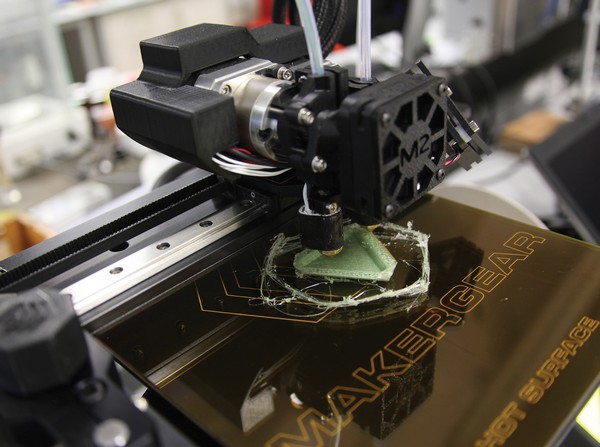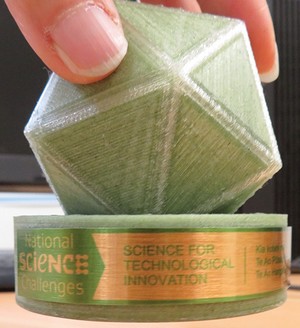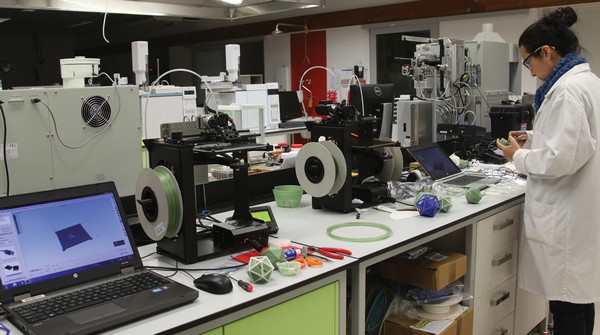Going bio: the next frontier in 3D and 4D printing

The worlds of 3D printing and biopolymers, such as protein, lignin, cellulose, hemicellulose and so on, are colliding, bringing about a new evolution of additive manufacturing where 3D objects are created by adding material layer on layer. 4D printing is an emerging additive manufacturing technology that will allow us to print objects that can reshape themselves or self-assemble over time. New Zealand is in a strong a position to make 3D and 4D printing of biopolymers and composites our speciality, with our abundant source of feedstocks that could be converted into biobased filaments.
New Zealand and 3D/4D printing
The advantages of 3D/4D printing and the strengths of New Zealand’s economy are a combination for success. Geographically isolated, New Zealand relies on importing and exporting goods. A thriving 3D printing industry would enable innovative and localised production that could function within our existing manufacturing network. This new industry could also bring the manufacture of some imports onshore and create new opportunities for manufacturing businesses to export higher value products.
This technology development could have multiple benefits for New Zealand ranging from the production of materials based on New Zealand’s biological resources and new customised products, to the development of equipment and enabling distributed manufacturing (geographically dispersed manufacturing facilities that are coordinated via the cloud) in existing and new companies. We see a big opportunity for New Zealand to lead the convergence of circular and bioeconomy technology and thinking with additive manufacturing.
What is Scion doing?
 General Manager of Manufacturing and Bioproducts, Dr Elspeth MacRae, is leading Portfolio 5 – Materials, Manufacturing and Applications – of the Science for Technological Innovation National Science Challenge (SfTI NSC).
General Manager of Manufacturing and Bioproducts, Dr Elspeth MacRae, is leading Portfolio 5 – Materials, Manufacturing and Applications – of the Science for Technological Innovation National Science Challenge (SfTI NSC).
The goal of Portfolio 5 is to see New Zealand developing and producing new materials and products based on the country’s biological resources and distributed manufacturing by 2025. The portfolio project team’s work will combine biomaterials with additive manufacturing methods such as 3D printing, electrospinning and layering.
The spearhead project on 3D printing using New Zealand biomaterials has brought together eight organisations, some of whom have never worked together before. The team created a 3D printed version of the SfTI 20-sided-solid (icosahedron) logo. The printed icosahedron was manufactured at Scion using a biopolymer/harakeke composite. The successful ‘print’ was presented to Science and Innovation Minister Paul Goldsmith in July 2017. The process from design to delivery was captured on video (http://bit.ly/2x1CBX0).
Scion has embarked on a number of other projects that combine 3D printing and biobased materials.
Dr Marie-Joo LeGuen worked with OceaNZ Blue to create 3D printed biodegradable bioplastic objects using paua shells, in addition to leading a research project funded by MBIE to develop 3D printing methods that use biobased materials, particularly primary industry by-products.
Biobased 3D printing was also used in our educational partnership with Te Taumatua o Ngāti Whakaue Iko Ake. Using CAD modelling to scan a traditional woven harakeke kete, the students created a 3D printed version using harakeke reinforced filament (Scion Connections Issue 24, Weaving mātauranga Māori and Scion science).
Dr Florian Graichen, Biopolymer and Chemicals Science Leader, says, “The development of 3D printing has allowed us to rethink the way we design and enabled the production of objects that have never been possible with traditional manufacturing techniques, creating new market opportunities. 3D printers are evolving on a day-to-day basis; and now we have an opportunity to influence the science behind the feedstocks of the future.”
On the horizon: biobased 4D printing
Scion, in collaboration with major research partners, is building a future where wood fibres, cellulose from other plant sources, and co-products from primary production can be combined in new plastic-like materials. The next frontier we will be tackling with biobased materials is 4D printing – printed objects that can reshape and assemble themselves over time. Watch this space.
For further information on our 3D printing programme, contact
Dr Florian Graichen at
Show email
